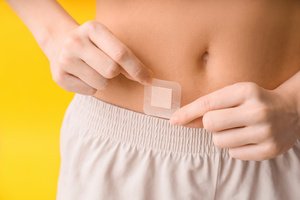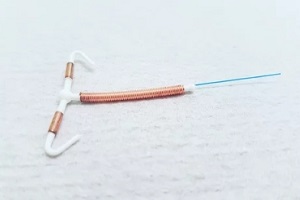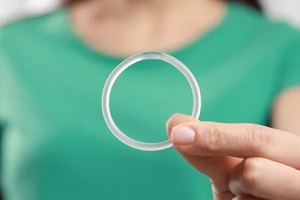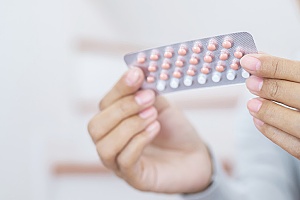 The birth control patch is a convenient, discreet contraceptive method that you stick onto your skin. But how does it prevent pregnancy on a biological level? What’s happening inside your body when you wear this transdermal patch?
The birth control patch is a convenient, discreet contraceptive method that you stick onto your skin. But how does it prevent pregnancy on a biological level? What’s happening inside your body when you wear this transdermal patch?
Let’s unpack the science behind it.
How the Patch Stops You from Ovulating
The combined estrogen and progestin in the patch suppress key hormones produced by your pituitary gland called gonadotropins. Specifically, they suppress follicle-stimulating hormone (FSH) and luteinizing hormone (LH).
FSH and LH signal your ovaries to mature and release an egg each month—which is the process of ovulation. The patch hormones interfere with FSH and LH to shut down ovulation at its source. Without an egg, the sperm doesn’t have anything to fertilize.
In addition, the steady estrogen makes the mucus in your cervix thicker. This mucus acts as a barrier that keeps sperm from swimming up through your cervix. This prevents the sperm from reaching the uterus and fallopian tubes, where they could find an egg.
The progestin also causes changes to the uterine lining. It prevents the endometrium from thickening enough for an egg to properly implant. This three-pronged action is how the patch effectively prevents pregnancy.
Steady vs. Cyclical Hormone Delivery
The transdermal patch allows the hormones to be directly absorbed through your skin gradually over the week. This leads to more continuous, stable blood levels of estrogen and progestin.
With daily birth control pills, you get a large spike of hormones all at once that then decrease steadily each day before you take the next dose. So, pills cause more peaks and valleys in hormone concentrations.
The steadier hormone delivery of the patch helps minimize side effects related to fluctuating hormone levels. Many women report fewer issues such as breast tenderness, nausea, headaches, or mood swings compared to the pill.
However, the total estrogen exposure ends up being higher with the patch. This sustained absorption means your body is exposed to 60% more estrogen over the course of a cycle compared to pills.
How Potent Are the Patch Hormones?
Pharmaceutical companies determined the ideal dosing by testing which combinations of estrogen and progestin effectively stopped ovulation. Clinical trials showed that average hormone levels of around 0.6-1.2 ng/mL for progestin and 25-75 pg/mL for estrogen reliably prevent ovulation.
 Your blood levels of both hormones stay within this target range all week long with the patch. There are no significant ups and downs.
Your blood levels of both hormones stay within this target range all week long with the patch. There are no significant ups and downs.
Factors such as heat, humidity, exercise, or contact with water don’t substantially impact the absorption from the patch. Your hormone concentrations remain stable in various conditions.
When the Patch Starts and Stops Working
It takes about two weeks of wearing a fresh patch constantly for your hormone levels to build up to effective ovulatory-suppressing concentrations.
So you’re protected from getting pregnant after having your first patch on for one full week. Backup contraception such as condoms is suggested for the first week just to be safe.
Once you stop using the patch, your estrogen and progestin levels return to your normal baseline within a month. Ovulation resumes, and you’re able to get pregnant again. This reversibility is a major benefit of the patch.
In clinical trials, the birth control patch was proven very effective when used correctly. Less than 1 out of 100 women got pregnant over a year. But with typical use, the failure rate rose to around 9 out of 100.
Proper weekly application is essential. Using backup protection is wise if you ever forget to change your patch on time or if the patch falls off.
Side Effects and Health Considerations
Since you’re getting regular doses of estrogen, the patch can cause some estrogen-related side effects. Many of these go away once your body adjusts within the first three months.
Common symptoms include breast tenderness, nausea, headaches, spotting between periods, and skin irritation where the patch is stuck. Mood changes, fluid retention, decreased sex drive, or weight gain may also occur.
About 20% of women get skin reactions at the application site. This side effect motivates some users to stop the patch altogether. Switching locations each week minimizes skin irritation.
A serious concern is the increased risk of blood clots in the legs or lungs compared to birth control pills. The patch elevates clotting risk about twofold. However, the overall likelihood is still low in healthy women.
Those over age 35 who also smoke should avoid using the patch due to their higher baseline clotting risk. Estrogen further amplifies this risk significantly.
 The patch may also not be an option for women with health conditions such as high blood pressure, obesity, diabetes, migraines, or depression. Certain medications can interact and make the patch less effective, too.
The patch may also not be an option for women with health conditions such as high blood pressure, obesity, diabetes, migraines, or depression. Certain medications can interact and make the patch less effective, too.
Your doctor will consider your medical history and assess whether the benefits outweigh the potential risks for you personally.
Figure Out If the Birth Control Patch Is the Right Choice for You with Raleigh Gynecology & Wellness
The birth control patch provides a unique hormone delivery method that many women find convenient and comfortable. While the risks of blood clots and other side effects should not be ignored, the patch remains an effective, reversible option for pregnancy prevention in healthy women.
If you’re interested in trying the patch or have any concerns about potential side effects for your health, Raleigh Gynecology & Wellness’s experts are here to help you.
Contact us today at (919) 636-6670 or schedule a consultation online, and our team will help you determine if the patch is the right fit for your needs and preferences.


 Perforation refers to a situation in which the IUD pierces the wall of the uterus. This complication is rare, occurring in about 1 to 2 out of every 1,000 IUD insertions.
Perforation refers to a situation in which the IUD pierces the wall of the uterus. This complication is rare, occurring in about 1 to 2 out of every 1,000 IUD insertions. Hormonal IUDs such as Mirena, Kyleena or Skyla can lighten periods or lead to no period at all. On the other hand, the nonhormonal
Hormonal IUDs such as Mirena, Kyleena or Skyla can lighten periods or lead to no period at all. On the other hand, the nonhormonal  The
The  Rinse the ring in cool water and reinsert it as soon as possible if It’s been out for less than 3 hours.
Rinse the ring in cool water and reinsert it as soon as possible if It’s been out for less than 3 hours. With the array of
With the array of  Progestin-only options avoid these concerns by excluding estrogen. The
Progestin-only options avoid these concerns by excluding estrogen. The  Several effective hormonal birth control options contain progestin but no estrogen. These progestin-only contraceptives include injections, implants, pills, and certain
Several effective hormonal birth control options contain progestin but no estrogen. These progestin-only contraceptives include injections, implants, pills, and certain  Mini-pills do not affect breastfeeding or harm infants in any way. This makes them a good birth control choice for postpartum women, allowing new mothers to prevent pregnancy without interrupting breastfeeding.
Mini-pills do not affect breastfeeding or harm infants in any way. This makes them a good birth control choice for postpartum women, allowing new mothers to prevent pregnancy without interrupting breastfeeding. Women with active liver disease: Progestin gets metabolized by the liver, so impaired liver function can be problematic.
Women with active liver disease: Progestin gets metabolized by the liver, so impaired liver function can be problematic.